A common theme throughout the history of earth mysteries is engagement with the spirit of places around us. Artists and writers have creatively explored this interface, and Mark Valentine suggests how drone music is exploring the same area
For the past 10 years or so, a new musical form has been emerging amongst independent artists and labels. It goes under a number of names, but one that seems to have stuck is ‘drone’. Like a lot of labels, it might originally have been in part a term of abuse. Critics of drone are apt to say things like, “oh, is that drone? I thought the washing machine had broken” or “why don’t you just turn the vacuum cleaner on and listen to that instead?”
There are other terms for it. Confluence, in May 2015, in Wimborne Minster, Dorset, described itself as “a microfestival of experimental sound and video” and was sub-titled “Minimal – Ambient – Drone – Field Recordings – Electronic”. That usefully sums up nearly all the various descriptions most often deployed. Similarly, A Closer Listen, a well-respected reviews blog announces on its masthead that it covers: ‘Ambient/Drone/Electronic/Experimental/Field Recordings & Soundscape/Modern Composition.’
We are talking about work characterised by long, slowly changing passages or structures. It often involves the “electronic manipulation of acoustic instruments, found objects and field recordings” as one practitioner, Mendel Kaelen, has put it.
Drone uses electronic and digital sources, treated instruments, and sound recordings of natural elements (wind, water, waves) and made noise (machinery, transport, public address systems). Found sounds, pure or untreated, are also deployed, such as creaking gates, foghorns, swing bridges.
Some reference points might help. There is the distant influence of European electronic groups: Tangerine Dream, Kraftwerk, Can, but also closer to home the BBC Radiophonic Workshop and maybe even that constant presence in the early 1970s album charts, Mike Oldfield. And, as I’ve delved into the drone scene, I’ve noticed hints of its ancestry from three movements I witnessed as a youth in the late 70s and early 80s.
The first was punk or new wave. The whole ethos of this was do-it-yourself. Bands put out their own records. “It was easy, it was cheap” said the Desperate Bicycles, one of the first, in 1977, to “go and do it!”. Here’s three chords, said another sleeve, with diagrams. That’s all you need. And alongside this rush of D-I-Y singles and cassettes there were also fanzines, Xeroxed cut-ups of jagged prose and slewed images. Similarly, many drone artists are dedicated to self-publishing and preserving their artistic independence.
The second was the earth mysteries scene. This comprised alternative archaeology, lost knowledge, ley lines, terrestrial zodiacs, dowsing, old stones, labyrinths and turf mazes, hidden holy wells. Atlantis and Avalon, and much else, evoked in many arcane, often home-produced, journals. As we shall see, aspects of this attentiveness to an enspirited landscape also emerge in much drone music.
The third was the supernatural fiction scene. Readers were rediscovering the work of Arthur Machen, Algernon Blackwood, William Hope Hodgson, Dion Fortune: strange tales, fantastic romances. And they were trying their own hand in this field too, in a mushrooming of independent publishers and small presses. Some of these, or similar, authors have specifically been cited as inspirations by drone artists.
I’m sure there were other scenes with a similar spirit, a similar ethos. But those were the three that attracted me. I soon got stuck into all of them. And in many ways I’ve never left them: I still look out for the things that are furthest out and, to me, drone is very much their heir. The contemporary musicians taking part in it were mostly not around or active in the early 1980s, so the alembic that formed me wasn’t what has worked directly on them. And yet there is a similar nexus in the drone ethos, an overlapping of strange music, strange history and strange literature.
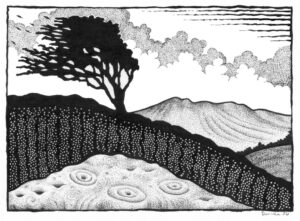
Many composers and performers currently working in this field are exploring its potential to engage with lost or remote landscapes and to convey the numinous, just as earth mysteries researchers and neo-antiquarians did and do. Often drone pieces are meditative: however, the form can also be used to suggest a mysterious, unsettling or even sinister atmosphere, sometimes explicitly linked to writers of supernatural fiction. Like those, they are attempting to convey the otherworldly.
Indeed, the classic authors of supernatural fiction are often inspired by landscape and particularly by ancient remains. The prime example is Arthur Machen, who wrote lyrically of the Welsh border country where he grew up, and of its domed hills, great rising woodlands, deep lanes, secret streams and pools. The enigmatic, finely shaded stories of Walter de la Mare often take place in lonely graveyards or obscure recesses of countryside. Algernon Blackwood won fame as ‘the ghost man’ when he told his stories on BBC radio: but in fact most of his work is about pantheism and nature spirits, the influence of woods, mountains and marshlands on susceptible individuals. Robert Aickman, one of the leading figures in 20th-century supernatural fiction, though he preferred the term ‘strange stories’, argued that at its best the ghost story is “akin to poetry”. He looked for a subtle, delicate effect upon the reader, “underlying but ever glimmering through”, as he put it.
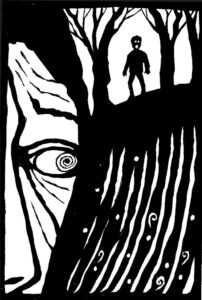
Scottish composer Brian Lavelle says of his music: “I suppose the closest thing I’d say it might be is ‘experimental electronic music'”. He is directly inspired by the strange stories of Robert Aickman, His label Dust, Unsettled, takes its name from Aickman’s story The Unsettled Dust. Aickman’s stories are often about dust: the dust that settles on old things, and is sometimes stirred into life: but also the dust that settles on us, on our lives, and how that dust may sometimes be raised too.
Several of his recordings also take their titles from Aickman stories: ‘The House of the Russians’ and ‘Just A Song At Twilight’. Aickman’s stories are oblique and sly. They have been characterised as ‘enigmatic’, even as ‘inconclusive’. They rarely introduce the supernatural overtly. Instead they build up a disturbing atmosphere. Their mood is fatalistic, and often his characters evince a sense of yearning for some different way of life just beyond reach, which contingency and circumstance prevent them from achieving. In the music of Brian Lavelle, there is that same sense of wistfulness, of reaching out to an unearthly realm just beyond.
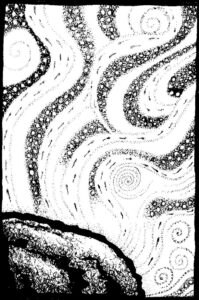
Brian’s work has also involved an element of earth-mysteries practice. He has recorded one of his albums, The Boleigh Working (2010), in collaboration with Matthew Shaw, in a fogou in Cornwall, a prehistoric subterranean stone chamber whose purpose is still unknown. It’s exactly the sort of place that used to excite the interest of my e.m. friends in the 1980s. And indeed one of Brian’s recordings references those days: it is called Atlantis and is dedicated to John Michell, author of the influential book The View Over Atlantis, and doyen of the earth mysteries scene. The term ‘working’, in the title, is of course used by practising magicians to identify a particular ritual. Brian has said of his fogou experience:
“Lit faintly by candlelight and by whatever remaining daylight could penetrate the opening, we recorded the various sections of The Boleigh Working live within the depths of Boleigh fogou itself. Ankle-deep in mud and cold water, we played and listened as the fogou listened and played with us.
The listener might hear odd noises in this recording which neither of us was responsible for producing: strange subterranean knockings and unexplained whirrings and whinings. It’s for the best, no doubt, that the voice of the woman (if that’s what she was) we both were convinced we’d heard down there, in the dark and the damp, whose spectral whispering caused the hairs on the back of our necks to stand up, wasn’t captured in any recognisable sense by the recording equipment.”
There were times when I was listening to the Fogou working when the sounds seemed to merge into what was going on around me, the sparrows and starlings on the birdfeeder, the distant hiss of passing traffic in the rain, and I seemed to be hovering in a sort of liminal space between the music and the outer world. And at other points I was catapulted back to the experimental artists I relished so much in my twenties, particularly Der Plan and This Heat, when I was just beginning to stretch my listening into unknown fields. There was certainly a sense of ritual and secrecy.
Brian worked with Matthew Shaw in the Fogou working and this artist has released other recordings inspired by the spirit of place, such as Lanreath, “a small village…the perfect base to disappear into sound, to meditate on the spirit of place, with excursions to the nearby Duloe stone circle for inspiration (and whatever else unknown and unseen) that may have influenced or affected the sounds and recording process”.
Matthew Shaw’s music often draws on the ancient places of the South-West, and he quotes the Theosophist Charles Leadbetter (on ‘The Astral Plane’) in relation to his recording The Etheric Double : “There are great Etheric currents constantly sweeping over the surface of the earth from pole to pole in volume which makes their power as irresistible as that of the rising tide”. That sounds like a description of the experience of listening to this sort of music. He also references supernatural fiction, with, for example, a piece named after Alan Garner’s Nemeton.
His work Tweoxneam is “a long form sound poem based… [around his] hometown, Christchurch. The mysteries of its apocryphal and actual history are soundtracked with a carefully unfolding procession of organic music and birdsong… The vision is very much twinned with the infinite village of Stanley Spencer’s Cookham [and] the Dorset world of Gerald Gardner, the appearance of Christ-like carpenters, and the still-sounding tocsins of neolithic power centres.”
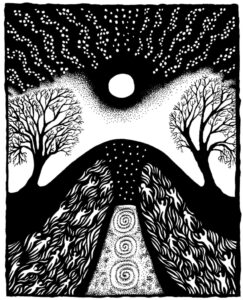
Again, that phrase about power centres and ancient resonances sounds like a product of the earth mysteries scene of the late 1970s and beyond. Some of the experiments at that time were about trying to pick up and measure energies at megaliths. For example, The Dragon Project led by Paul Devereux, then editor of The Ley Hunter, was founded in 1977 to research and test “the rumour (existing in both folklore and modern anecdote) that certain prehistoric sites had unusual forces or energies associated with them.”
We might link that to Grey Ladies (2014), from Sybella Perry, a piece named from a stone circle near Elton, Derbyshire. This work describes itself explicitly as “a composition of field recordings that documents a series of attempts to resonate a stone circle. Using amplified and acoustic vocals alongside pure sine wave tones these exercises set out to test theories surrounding the construction of megalithic sites as acoustic environments”.
One listener, Chris Whitehead in The Field Reporter, noted that “it plays like a ritual. It plays like a meditation, an attempt to form a conduit between different states of matter and between civilisations separated in time. It takes the form of a summoning prayer for hidden phenomena. When listened to in the dark with those winds lashing the windows and the rain throwing nails at the roof, thinking about the megaliths still out on the moors, enduring as they always have done, that’s what resonates. I can vouch for that”. That sense of a connection between a drone composition and a different state of being and a different world is precisely what is felt by many listeners.
Brian Lavelle has also recorded with Siren Wire, the label run by Susan Matthews. Matthews describes her work as “experimental music”, and others have talked of its “dazzling abstractions of grace and beauty”. Writer Dan Schaffer describes her music as: “poetic laments, ghost voices, and industrial noise. She’s successfully combined fragmented conversations with broken music, and desolate pianos with quietly ominous electronic tones to create soundscapes with astonishing emotional complexities”.
Susan Matthews’ recording, Shadow Wraiths (2015), suggests simply in its title an engagement with the realms of the supernatural. Although she rarely seems to speak about her work, it carries the description: “Shadow Wraiths is a meditation on moving from darkness into light – from despair to hope and the rebirth of energy… From the depths of midwinter towards spring”.
A deep slow opening movement, with bursts of church organ, suggests a solemn and patient force. The recording opens out with rising chords that suggest sunrise. Then there is a sudden change, heralded by a gong-like stroke as if from a grandfather clock, followed by further chimes. The music becomes more hesitant, questing. This gentler movement is succeeded by a piano melody, softly repeated, treading like footsteps, and is soon joined by joyous birdsong. A low murmuring drone, barely audible, follows.
It’s often said with the finest drone that it sometimes blends with everyday sounds so that it is hard to discern where one ends and the other begins: the world of the music and the world of the everyday touch and overlap. That was my experience of Shadow Wraiths: as the recording dropped to a low murmur the birdsong from my own garden and the distant hum of the road seemed to reach in to join the music.
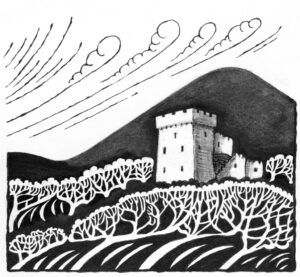
Ian Holloway has recorded and performed with Susan Matthews. He says: “I usually describe my music as ‘quiet psychedelia’. I like the term psychedelia because it evokes colour, texture, depth and scope”. The width and opening of his music is partly as a response to his origins. He explains:
“I grew up in the deepest darkest part of the Welsh valleys. I never really saw a sunrise or sunset until I left. The valley is steep and the mountains are relatively high. it gets gradually lighter and then gradually darker. Life there seemed static, stuck, restricted…I always dreamed of living by the sea. Its space, its freedom, its openness, its ferocity, its calmness and its presence all inspire and contribute to my music and I can’t imagine it not being there.”
His work is inspired by the coast of the Gower peninsula, but also makes use of such simple local features as a swinging gate in a park. Speculative fiction is also an inspiration:
“As soon as I pressed my first synth key all my years…reading people like John Wyndham, John Christopher and HG Wells came flooding back. These fictional landscapes of post war Britain (and the earlier ones of people who I’m only just discovering such as Machen, Hodgson, James)…are just so evocative.”
Richard Skelton is also an attentive reader of these supernatural fiction writers, and his music’s profound engagement with landscape is equally clear. He comments:
“when I spent five years in relative seclusion in rural Lancashire…I had a kind of epiphany. A return to what mattered. Moreover, I discovered that the natural landscape isn’t merely pretty, or scenic, or picturesque. My experiences out there in the woods and fields can really only be described as a spiritual reawakening – but one which had no reference to God or any specific religion.”
He also seeks to draw his music out of the physical terrain itself:
“I wouldn’t make music if it wasn’t a meaningful act. A gesture. A ritual. Nature, the landscape, and its history are the source of my inspiration… I would bury strings beneath stones or soil, or in the river’s shallows. I’d leave small instruments (a zither, singing bowl, chime bars) out in the landscape for weeks, before reclaiming them and using them in the studio. I’d collect various natural ephemera (stones, bark, pine cones, feathers & bone) and use them as plectra to sound my instruments. These “thing-poems” acted as a symbolic connection to the landscape itself. “A flint for the memory.”
In the work of Richard Skelton, and in his collaborations with Autumn Richardson, there is a strong and sustained concern with how we respond to landscape, to our environment, and also with how the written word and music can work together to memorialise what is lost or fragile: local and dialect terms for places and natural things, field names, maps not just of the physical but of the spiritual.
What do these composers and musicians have in common? For that I’d like to invoke Arthur Machen. All his life Machen held to the idea that the visible world is only a façade, a symbol of a far greater and stranger world beyond. What we see is not what is, the ultimately Real. But at some places the veil is thinner and it is possible to glimpse a different domain. Machen believed that the highest literature could also suggest glimpses of the world beyond. And that, I suggest, is the sense we sometimes get with the finest work of contemporary drone composers: that we are on the edge of another dimension, that we are treading towards a different terrain.
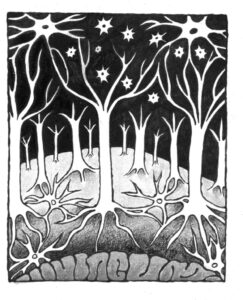
Artwork by Davina Ware
Published in NE154 (September 2018), pp.13-18